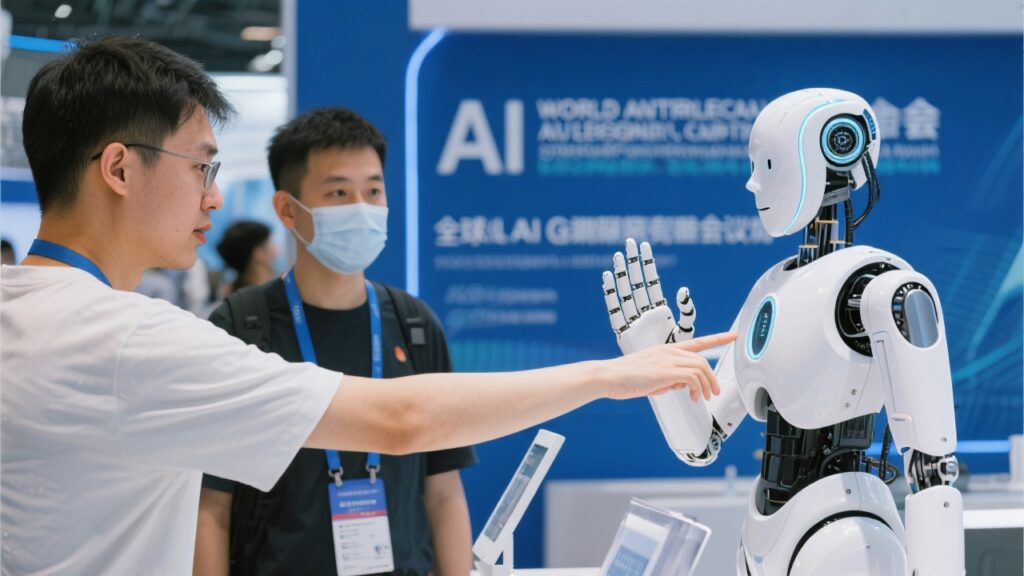In the bustling halls of Shanghai’s World Artificial Intelligence Conference last year, a visitor reached out to touch a humanoid robot’s hand, symbolizing more than just a tech demo—it was a glimpse into China’s vision of blending human cognition with artificial intelligence. As we step into the latter half of 2025, the global race to develop brain-computer interfaces (BCIs) is heating up, with China emerging as a formidable contender. While companies like Neuralink in the US grab headlines with flashy announcements, China’s state-backed initiatives are quietly advancing technologies that could redefine human-machine interaction, from medical miracles to potentially transformative AI capabilities. This isn’t just about helping the disabled regain movement; it’s about pursuing a deeper merger of mind and machine that could propel artificial general intelligence (AGI) forward in ways the West might not anticipate.
At the heart of China’s strategy is a relentless focus on BCIs, devices that create direct pathways between the brain’s electrical signals and external computers. These interfaces come in various forms—invasive ones that require surgery to implant electrodes directly into or on the brain, minimally invasive options, and noninvasive versions that use external sensors. China’s efforts span all these, driven by a mix of medical innovation and broader ambitions for cognitive enhancement. For instance, researchers at institutions like Tianjin’s Haihe Laboratory have developed a series of BCI products under the “Shengong” banner, including exoskeletons that help stroke patients walk more naturally by analyzing and correcting gait patterns against vast databases of normal movements. Another device acts like a “brain whisperer,” an implantable chip that boosts the accuracy of brain signal detection, aiding in everything from depression diagnostics to controlling extra robotic limbs with mere thoughts.
This progress isn’t happening in isolation. It’s part of a larger ecosystem fueled by China’s long-term science and technology policies, outlined in successive five-year plans that emphasize self-reliance in key areas like neuroscience and AI. The China Brain Project, launched about a decade ago, embodies this approach by integrating neuroscience with brain-inspired computing—also known as neuromorphic computing—which mimics the brain’s efficient processing to create more powerful, energy-saving AI systems. Unlike Western initiatives that often prioritize pure neuroscience discoveries, China’s project explicitly aims for human-machine hybrid intelligence, blurring the lines between biological and artificial cognition. This fusion is seen as essential for achieving AGI, an AI that matches or surpasses human intelligence across all domains, without relying solely on the massive data-hungry models popular in the US.
Experts point out that China’s path diverges from the American fixation on scaling up large language models, like those from OpenAI. Export restrictions on advanced chips have pushed Chinese researchers toward alternative routes, such as embodying AI in real-world environments for interactive learning. A pilot program in Wuhan exemplifies this: it’s incubating an AGI system integrated into the city’s industry, commerce, and daily life, with plans to expand across Hubei province and eventually the nation. This “embodied” AI learns from constant human-machine interactions, potentially leading to more adaptive and human-like intelligence. As one analyst noted, true human-equivalent AI won’t come from just cranking up model parameters; it requires adding sensory and physical modules, something China is aggressively exploring.
The medical breakthroughs are already impressive. In a landmark development earlier this year, a team from the Chinese Academy of Sciences’ Center for Excellence in Brain Science and Intelligence Technology, working with Fudan University’s Huashan Hospital, conducted China’s first clinical trial of a high-throughput wireless invasive BCI. A patient paralyzed from a spinal injury 13 years ago underwent minimally invasive surgery to receive the implant. Within weeks, he was controlling games and devices purely through thought, describing the experience as regaining a sense of freedom. The implant, coin-sized and ultra-flexible, minimizes tissue damage—far smaller and more pliable than counterparts from Neuralink. Researchers are now expanding its use to robotic arms, allowing the patient to perform everyday tasks like grasping objects, with future goals including controlling advanced robots.
This isn’t just about individual recovery; it’s tied to national narratives of rejuvenation and technological independence. State media often highlights these advances as symbols of “Chinese-style modernization,” showcasing how BCIs could help millions with spinal injuries, amputations, or neurodegenerative diseases. Yet, the dual-use potential looms large. China’s military-civil fusion policies mean innovations in BCIs and related neurotechnologies could enhance soldier performance or enable new forms of surveillance. Imagine systems that not only read brain signals for control but also infer mental states, potentially influencing thoughts or detecting dissent. This ties into broader concerns about data-centric authoritarianism, where emerging technologies like AI surveillance, quantum computing, and digital currencies amplify state control.
On the global stage, China’s BCI efforts are part of a toolkit that could export repressive models. The country leads in developing “city brains”—AI systems that fuse data from cameras, sensors, and devices to monitor urban life in real time, preempting unrest. Neurotechnologies extend this inward, potentially accessing private thoughts via commercial devices, with laws ensuring state access to such data. Quantum advancements threaten to crack current encryption, exposing dissidents worldwide, while China’s digital yuan enables seamless transaction tracking, complicating international sanctions. These tools aren’t just domestic; they’re exported, often with training for local forces, helping regimes from Africa to Latin America bolster surveillance without building everything from scratch.
Comparatively, the West isn’t standing still. Elon Musk’s Neuralink has implanted chips in a handful of patients, with one reportedly using it for over a year to play games, read, and even engage in virtual conversations. Synchron, another US player, leads in implantation numbers with a less invasive stent-based approach, backed by heavyweights like Jeff Bezos and Bill Gates. It focuses on simple controls but emphasizes scalability and safety. In Europe, research remains more academic, lacking the aggressive push seen in the US or China. Yet, China’s state support allows for rapid scaling—partnerships like the one between the Chinese Institute for Brain Research and Neucyber Neurotech plan over a dozen implants this year, with larger trials slated for 2026. Another firm, Neuracle Neuroscience, is running studies in both China and the US, blending semi-invasive tech with global ambitions.
Investment plays a crucial role here. Chinese investors emphasize the need for “patient capital” in this field, warning against treating BCIs like quick-profit internet startups. One prominent backer, who has funneled millions into neuroscience, argues that true innovation requires decades, not rushed IPOs. Startups like NeuroXess and BrainCo have raised hundreds of millions, fueled by a mix of state and private funds, pushing valuations skyward. This contrasts with the hype-driven funding in the West, where ethical concerns—such as Neuralink’s animal testing controversies—sometimes slow progress.
Looking ahead, 2025 could be a pivotal year. With China aiming for market-ready BCIs by 2028, including standardized pricing for implants, the technology might soon become accessible for widespread medical use. But the broader implications are profound: a world where humans depend on embedded AI for enhanced cognition, potentially erasing distinctions between natural and artificial intelligence. While this promises empowerment—think seamless human-machine teaming for complex tasks—it also raises alarms about privacy, autonomy, and geopolitical power. China’s recruitment of global talent, offering massive funding to innovators while insisting on relocation, underscores its determination. Some, like a pair of brothers who developed brain-inspired algorithms, turned down lucrative offers fearing military misuse, opting instead for US collaborations.
In the end, China’s fusion of man and machine isn’t just about catching up—it’s about redefining the rules. As the world watches, the balance between innovation’s benefits and its risks will shape our collective future. Will this lead to a more capable humanity, or a more controlled one? Only time, and the choices we make, will tell.

